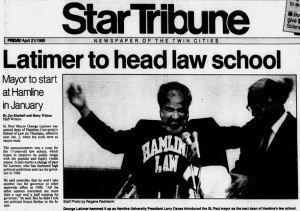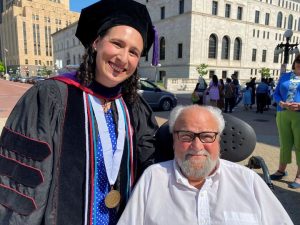
George Latimer, who served as dean of Hamline University School of Law after stepping down as the longest-serving mayor in St. Paul history, died in the early morning on Sunday, Aug. 18, at age 89.
Latimer was as known for his good-natured personality as any policy wins, though a robust redevelopment of downtown St. Paul stands out from his tenure as mayor. He was also easily the best-known dean in Hamline Law’s history, given his popularity after 14 years at city hall. The news conference in April 1989 to announce his appointment was front page news in the Twin Cities.
Latimer’s tenure at Hamline Law began the day after he left the mayor’s office and lasted three years until he departed to serve in President Bill Clinton’s administration in 1993. Latimer came to the job of dean with the same enthusiasm he had as mayor. He oversaw a law school that enjoyed increasing enrollment and a rise in stature of what remains a nationally recognized Dispute Resolution Institute.

Latimer’s appointment as dean of Hamline Law is front-page news, 1989.
Yet, his former colleagues also note Latimer’s mere presence was its own legacy for Hamline Law. “When he chose to serve as dean, it in some measure validated what was happening at the law school,” said Ed Butterfoss, a longtime professor who would also later serve as Hamline Law’s dean. “With his life and career as a lawyer who turned to public service, he embodied the ideal at Hamline—lawyer as servant leader.
“But more than that, George’s exuberance, ambitiousness, and optimism energized the law school. It was clear he cared deeply about the professional and personal well-being of the students, staff, and faculty.”
Born on June 20, 1935, in Poughkeepsie, N.Y., Latimer often worked in his youth at the small grocery store ran by his parents. He met Nancy Moore at a high school dance; they married six years later, in 1959. During Latimer’s final year at Columbia Law School, a roommate’s family offered Latimer the chance to clerk at a firm in St. Paul.
Nancy and he moved in 1963 and never left, raising their five children in the capital city. Latimer practiced labor law while getting involved with DFL politics. He was elected to the St. Paul School Board in 1970 and was serving as a University of Minnesota regent when he eked out a 2,200-vote win in the 1976 mayor’s race against a former mayor.

Latimer smiles at his installation as Hamline Law dean, 1990.
Two years later, St. Paul became an epicenter of the gay rights movement, when an amendment was placed on the ballot to remove the city’s groundbreaking gay rights law. Latimer fought to defeat the amendment. That effort failed, even as he easily won reelection.
Latimer’s popularity grew, thanks to a reputation as a pragmatist who brought together factions to get deals done. He also kept his number listed in the phone book, despite the occasional crank call.
In 1986, Latimer tried to cash in his popularity by running for governor of Minnesota. He faced another popular politician – the sitting governor, Rudy Perpich, in the DFL primary. Perpich trounced Latimer by nearly 17 points. The St. Paul mayor only won the vote in two counties, Ramsey and Dakota.
He later quipped in a 1990 interview that “every time I declined to run for higher office, I was more popular. When I did run, I got my block knocked off.”
Even after he declined to seek a seventh term as mayor in 1989, Latimer’s name remained in speculation for another run for governor in 1990. But his private job hunt went a different direction. In addition to the Hamline Law deanship, Latimer had applied to be dean of Harvard Law but withdrew from consideration because his family wanted to stay in St. Paul.

Latimer (right) and Minneapolis Mayor R.T. Rybak visit before an appearance at the Minnesota State Fair, 2013.
The questions around another political run continued even after he became dean. State Sen. Richard Cohen of St. Paul led a “draft Latimer” campaign, but the former mayor remained adamant about staying put. “I’d rule it out,” he told the Associated Press in March 1990. “I’ve made a commitment to Hamline and I’m very happy here.”
In 1993, Latimer stepped down from Hamline Law after accepting a job as a special consultant to then-U.S. Housing and Urban Development Secretary Henry Cisneros. The two had gotten to know each other while both serving as mayors (Cisneros in San Antonio).
“George Latimer’s true affection for Hamline Law became clear when he returned to Saint Paul from D.C. and frequently attended not only formal law school events but also informal gatherings of the faculty and staff,” recalled Butterfoss. One such event included attending his granddaughter’s graduation from the law school in 2023. “He will always be remembered by those who served with him at Hamline as the dean whose initial reaction to ideas rarely was ‘we can’t do that,’ but instead typically was ‘why can’t we do that?’”

Latimer attends his granddaughter Sophia’s graduation from Mitchell Hamline, 2023.
In 2015, Hamline Law combined with William Mitchell College of Law to create Mitchell Hamline School of Law. Latimer remained connected with the new law school, including attending his granddaughter’s commencement ceremony when she graduated from Mitchell Hamline in 2023.
“Ed [Butterfoss] and I both thought George’s biggest accomplishment was to create an air of optimism and pride in the law school,” said Marie Failinger, another longtime professor who chaired the search committee that brought in Latimer in 1990. “And he did all of that just by being himself.”
Latimer’s wife, Nancy, died in 2006. He is survived by his five children. In 2014, the St. Paul Central Library in downtown was renamed for Latimer.
At the 1989 press conference announcing his appointment as dean, Latimer was asked how he would like the people of St. Paul to remember him. His answer: “That I wasn’t much until I became dean of Hamline University Law School.”
Funeral services will be held at 10 am on Aug. 26 at Church of the Assumption, 51 W. Seventh St., St. Paul.
